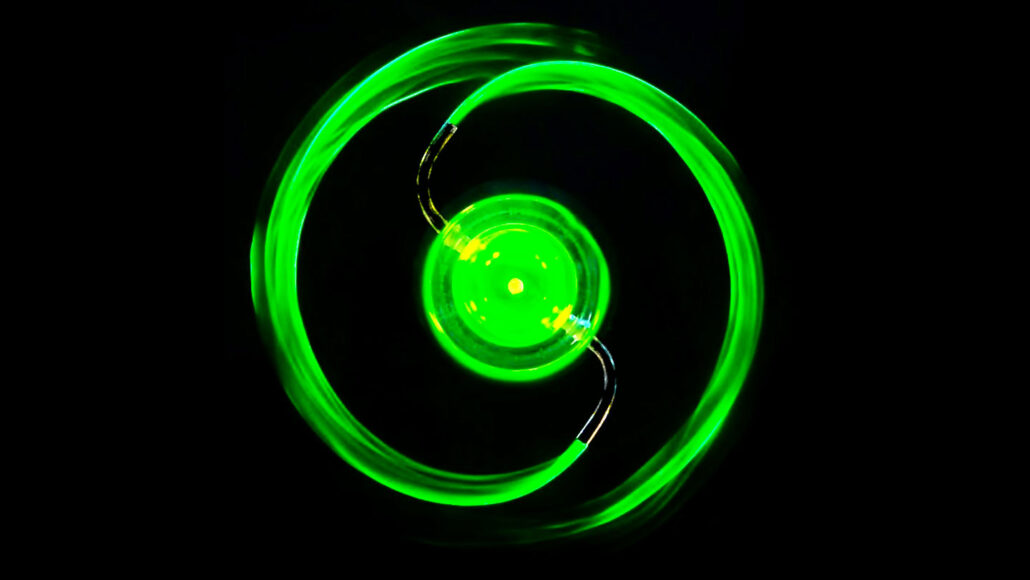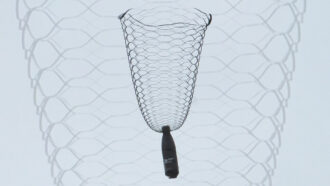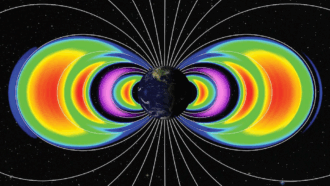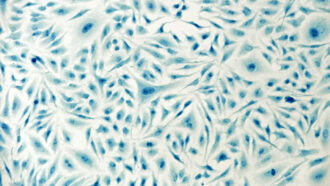Physics explains what happens when a lawn sprinkler sucks in water
Jets and vortices in the sprinkler make it twirl in the direction opposite to normal

An S-shaped sprinkler spins counterclockwise as it expels streams of water (visualized with green dye). But what happens when the sprinkler is stuck underwater and now sucks in water?
Applied Math Lab/NYU
Share this:
- Share via email (Opens in new window) Email
- Click to share on Facebook (Opens in new window) Facebook
- Click to share on X (Opens in new window) X
- Click to share on Pinterest (Opens in new window) Pinterest
- Click to share on Reddit (Opens in new window) Reddit
- Share to Google Classroom (Opens in new window) Google Classroom
- Click to print (Opens in new window) Print
Physicists are fascinated by many grand puzzles. The nature of space and time? Sure. How the universe came to be? Of course. But how lawn sprinklers spin? Yes, that too.
In the 1980s, physicist Richard Feynman made one sprinkler-related question quite popular. It centered on a style of sprinkler that squirts water out the ends of an S-shaped tube. The sprinkler normally spins away from the escaping water.
But what happens if you stick the sprinkler in a tank of water and have it suck in water?
The question seems simple. But it involves complex fluid flows — and complex rules of physics.
Some physicists had thought a submerged sprinkler should spin in the opposite direction to what it normally does. Others said it shouldn’t move at all. Experiments have likewise showed different results.
So Leif Ristroph and his colleagues decided to give it a whirl. Ristroph is an applied mathematician in New York City. He works at New York University. “It ended up being one of the hardest problems our lab has ever worked on,” he says.
The team did experiments with a carefully crafted, see-through sprinkler. To reduce the friction that had messed with results of past tests, they now had the device float in a tank of water. When run in reverse, the sprinkler now rotated the opposite way it normally does.
Ristroph’s group described its findings in a paper accepted to Physical Review Letters.
Further experiments revealed why the sprinkler spun backwards. In these tests, Ristroph’s group added tiny particles to the water. Lasers lit up those particles to show how they moved. This, in turn, showed how water moved inside the sprinkler.
The sprinkler normally spew jets of water out. But run in reverse, jets formed inside the sprinkler itself. Importantly, the jets weren’t symmetrical, even though the arms of the sprinkler were perfectly aligned. That’s because moving through the sprinkler’s curved arms disrupted the flow of water in each jet. So when the jets met in the middle of the sprinkler, they didn’t collide head-on. Now, they glanced off each other.
These off-kilter collisions formed four vortices inside the sprinkler. Like the jets, these swirls of water were asymmetrical. And that mismatched rotation set the sprinkler spinning backward.
The sprinkler puzzle’s solution just demanded a spritz of insight.







